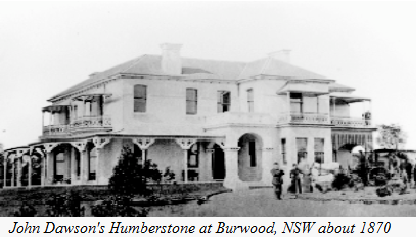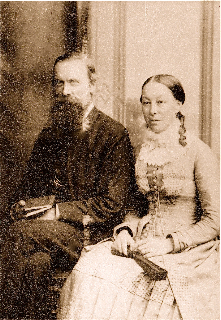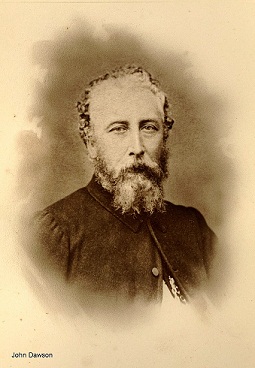

|
On the spot with striving settlers Law Society Journal, March 2012, vol 50, no.2 Review by Philip Burgess Family histories are mostly of appeal to the family's members but this production goes a lot further, linking a particular family with the history of 19th-century immigration and settlement in NSW. In 1835 John Dawson, a Lincolnshire gardener, at the age of 47 migrated to Australia with his wife and eight children. The book tells their story through several generations up to the First World War. At least three Dawsons became early members of the NSW legal profession and others became wealthy through land, or prospered through trade. For most Dawsons, life in NSW, despite early hardships, was better than "at home". One branch, the Davys, ended up developing Neutral Bay and Northwood after owning Harrington Parkat Camden for twenty years. Others became medical professionals, engineers, architects and businessmen. Like those of this century, 19th century migrants had a strong desire to better themselves. "Man does not migrate out of despair, but out of hope", as Sir Keith Hancock, quoted on the title page, put it, and the Dawsons had plenty of that. What makes this book stand out is the artful use of all kinds of pictorial material - photos, plans of maps, real estate brochures and other illustrations appear on almost every page. On p.65, for example, next to an 1850s plan of Harrington Park is a gallery of contemporary photos. The author has put her expertise as a librarian to good use, as well as having done a truly amazing amount of research. Fortunately, the family members were letter writers and much material still exists. Ms Laidlaw manages to tie it together in a coherent narrative. The Dawsons had Quaker connections, but these did not inhibit their pursuit of worldly success. One such connection, Joseph Neave, became a missionary in the United States during the civil war, not a good scene for a pacifist during the greatest internal conflict the US has suffered. He later went to Russia, meeting Tolstoy, among others, to plead for the Stundists, a persecuted religious group, with some success - it seems the Tsar acted on Neave's petition and the persecution ceased. The level of detail in this book is almost overwhelming and, given the huge cast of characters, the story is hard to follow. However, the author does manage to re-create the atmosphere of all this striving, and put the reader on the spot, as it were. Others like Geraldine Brooks in Caleb's Crossing and Kate Grenville in The Secret River have brought to light the struggles of early settlers through fiction. This book is at the opposite pole, but it does the same.

Joseph James & Helen Neave 1872
FAMILY JOURNEY OF FASCINATION The Canberra Times, Saturday 14 May, 2011 Reviewer: Robert Willson Professor Manning Clark once spoke in praise of family and local amateur historians. In a memorable phrase he said that there is a small army of enthusiasts “burrowing around in the recesses of Australian history”. Helen Laidlaw, a retired librarian, has devoted 20 years to researching the Dawson family who came from the area around Grimsby, Lincolnshire. What became a vast Australian family began when John Dawson and Mary Hocknell in 1809. John had worked all his adult life as a gardener and farmer in the Grimsby district. The title of this family history of John and Mary and their four boys and five girls, suggests that his decision to come to Australia was a gamble. In fact as historian Sir Keith Hancock reminds us in words quoted in this book: “Man does not migrate out of despair but out of hope”. If the Dawsons took a gamble then that gamble paid off handsomely. Australia proved to be a land of opportunity where people could rise above the old class distinctions of England. The Dawsons became important lawmakers and landowners. In 1835 the Dawsons decided to emigrate on a ship called the Canton. The 15-yr-old son of John, also called John, kept a journal of the voyage and this document has been of great help to Laidlaw in the first part of her story. However she devotes an early chapter to sketching in the family background in Lincolnshire. The incidents and adventures of the voyage are described vividly, based on young John’s journal. On arrival in Sydney Cove on September 3, 1835, the ship had to anchor in Spring Cove and spent the whole of that month in quarantine before passengers finally were allowed ashore in Sydney. The chapters that follow detail the activities of the family in their new home. The early months for John Dawson must have been a struggle, but in 1838 he leased a farm at Kiama. His pioneering struggles and then in the Illawarra district are carefully researched. It is clear the Dawson family kept in touch in a spirit of family solidarity and preserved their family records. In a brief review, it is not possible to do justice to the amazing amount of detail that the author has assembled. For those with family links to the Dawsons, this book will prove a goldmine of information. Members of the family were linked to some of the most notable names in Australia, including the Macarthur family of Camden and the Murrays of Yarralumla. One cannot fault the research in the book but I think the material should have been shaped into several volumes. The sheer mass of detail is a little overwhelming. There are many illustrations for every person and every place mentioned, but they are reproduced on such a small scale that details are hard to appreciate. However the author is to be commended on preserving so many valuable family records. * Robert Willson taught religion and history for many years |
The Gardener’s Gamble Quakers Australia. NSW Regional Newsletter, July/ August 2011 Book review by Frances Parsons, Tasmania Regional Meeting. Helen Laidlaw’s The Gardener’s Gamble is, as she says on the title page, ‘A Social History of Australia through the Dawson Family’. ‘The gambling gardener’ was her great, great, great grandfather, John Dawson, who with wife Mary and eight children came to Sydney on the Canton in 1835, hoping to improve their standard of living and social status. The experiences and rigours of that journey (in a purpose built migrant ship) and the enforced on-shore quarantine (because there had been smallpox on board) are recorded from the day they left England in the journal kept by John, the 15-year old son. They were a literate family, and the author has been fortunate in having access to many journals, scrapbooks, collections of letters and photographs. The text has been enriched by frequent quotation from these and other primary sources, as well as by the many illustrations. Her research led her to archival material in State, University, newspaper, school, Quaker and town collections; glance at the bibliography and notes at the end of the book, before you begin at the beginning. It took Helen 20 years to piece together. Despite the uncertainties, the accidents, illnesses and deaths, the family prospered, and there is much interesting detail about the way districts such as Camden and the Illawarra were settled, and about the role members of the family played in setting up hospitals, schools, agricultural shows, Blind Institutes and general social amenities. Even a bill of sale throws light on farm and household equipment. The amount of work done by women is staggering. From 5am to 11pm they had the dairy herd to milk (twice), milk to set in pans for the cream to rise, butter making, (and marketing) the hens, lambs and pig pens to see to, household scrubbing and polishing, laundering, dressmaking, mending, gardening, and of course cooking, preserving and bottling the produce of the fertile soils of the farms which they leased until they could buy. It was during this early period that the Quakers, Backhouse and Walker, visited the Australian colonies, and the Dawson family often attended Meetings for Worship arranged by them as they tramped the Illawarra, Jervis Bay, Shoalhaven and Camden districts. Backhouse had as secretary Abraham Davy, a reformed convict (whom Backhouse had possibly first met at Macquarie Harbour), who began to court Jane Dawson. This raised difficult questions for early Quakers regarding the status of emancipists and the role of ‘disownment’. Central to the difficulties was the question of ‘marrying out’ (i.e. marrying someone not in good standing in the Meeting). Friends from Hobart (the ‘Senior’ Meeting) came to Sydney to help sort out the problems. Among them were Robert and Joseph Mather. Abraham and Jane, impatient of the dissention, married in a Presbyterian Church in 1838 and not long after Abraham was ’disowned’. However, they remained in close contact with Friends and Davy exchanged letters with Backhouse for many years. Another of the problems among Friends in Sydney was a split between a group of enthusiastic young Friends and the older, conservative Members. At one time, police locked the young group out of the Meeting House. About this time, another pair of Quaker missionaries visited: Joseph James Neave and Walter Robson, as did Francis Cotton of Kelvedon. Neave became enamoured of Helen Davy, daughter of Jane and Abraham. Their courtship was protracted as Neave wanted to complete his travelling in the ministry, but they were eventually married in Saffron Walden before returning to Sydney where they did much to revive the Meeting. Their eldest children attended the Friends’ School as boarders. Among the luggage of the Dawsons on the Canton was a cradle. Their own family was complete but they must have been looking to the future — there are 70 grandchildren listed in the family trees at the end of the book. As the author says in her conclusion The Grimsby Gardener’s gamble had paid off … within three generations the family included an architect, artists, bank managers, barristers, businessmen, chemists, doctors, engineers and a judge.
The Daily Telegraph (Sydney), 28 May 2011 Reviewer: Barbara Baker The Gardener’s Gamble will be the envy of many a family historian. Lavishly printed on large, satin-textured pages, every margin decorated with cameo illustrations in sepia or colour, this glamorous publication adds style and gravitas to the story of John and Mary Dawson and their descendants. The Dawsons arrived in Australia from Grimsby, in eastern England, with eight of their children in 1835. Smallpox on the ship scarred three of the girls and also necessitated a harrowing month in quarantine. John failed to obtain a land grant, so leased farms at Kiama, near Wollongong, then at Jervis Bay. His children, by dint of education, marriage and initiative, prospered as landowners, engineers, lawyers, traders and so on in NSW and Victoria. Gardener John’s ‘‘gamble’’ paid off. Meticulously researching family papers, diaries, newspaper ads and more, Helen Laidlaw revives their fortunes and preoccupations as part of life in colonial Australia. She also documents the lives of, or contacts, many notable figures including the Quaker fraternity, Thomas Mort and ‘‘ Breaker’’ Morant. The Gardener’s Gamble is so packed with information that it is less of a general read than a research tool. With appendices on Kiama Aborigines and on a Quaker diary from the American Civil War, and end-notes, index and bibliography, it deserves a place in every library.
John Dawson II, the writer of the journal |
